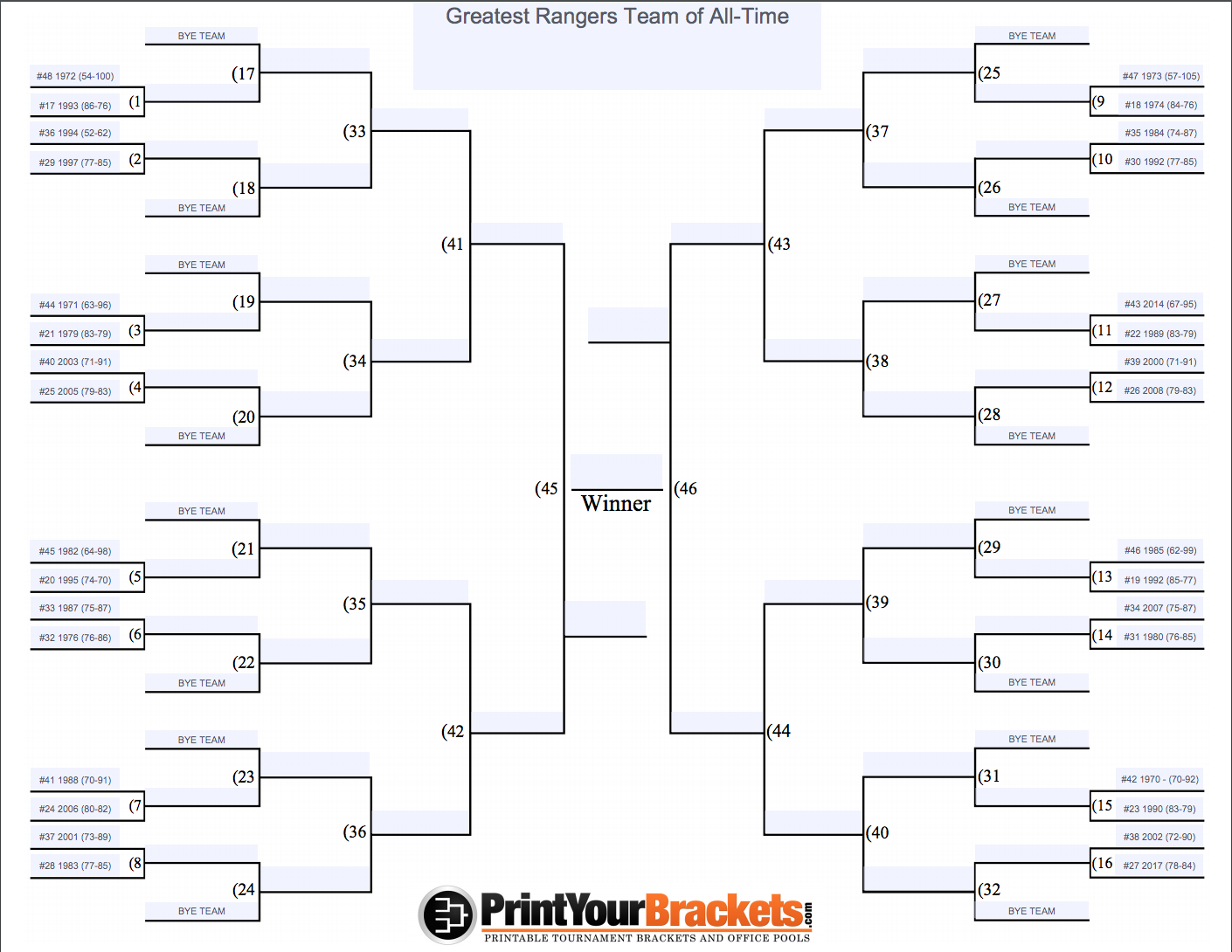With the Rangers’ offseason in stealth mode for the last few months, and two and a half weeks yet to go before pitchers and catchers report, it’s time to get creative with baseball coverage. It’s time to invent some impossible questions and try to answer them. Here’s the one I settled on: if every Texas Rangers team in history were to play in a tournament, who would emerge as the greatest Rangers team of all time? What if we could pit the Hamilton / Napoli / Cruz / Beltre Rangers of 2011 against the Gonzalez / Palmeiro / Pudge / Greer Rangers of 1999? And what of the rest of the field? Would an underdog arise? (Perhaps some Michael-Young-and-A-Rod-led team from the early 2000s?)
I didn’t think it would be possible to do this without using my own bias and conjecture, but it turns out, WhatIfSports.com is a website that already exists (this is not an ad, it’s just the site I found that already does what I need). I did some tinkering and while the default lineups aren’t always accurate (they had Nomar Mazara patrolling CF for the 2017 Rangers), the simulation seemed pretty legit. I think we can do this.
First, however, we need ground rules:
1. Players in the starting lineup must have been actual contributors for the Rangers in that season. The guidelines I settled on were:
– 45 games for a position player. This allows for some trade-deadline players to make the cut, but only if they were major contributors. For perfect examples, see the 2016 lineup, which features Carlos Beltran (52 games) and Jonathan Lucroy (47 games).
– For pitchers, they must have pitched a minimum of 75 innings for a starter, or 30 innings for a reliever. By these metrics, both Cole Hamels and Sam Dyson are eligible to pitch for the 2015 team.
2. Players must play a position that they actually played that season (So, no matter how much sense it would have made to me, I can’t put Adrian Beltre at first base).
3. I make the lineups and determine the starting pitchers. The only reason I’m putting this caveat in is because it would be insanely time-consuming to go back and determine who hit in what order the greatest number of times in any given year. My goal here won’t be to arrange the lineup as *I* would have made it, but to try my best to get something representative of the team. Fortunately, batting order doesn’t matter that much.
Next, we have to determine the structure of the bracket. There have only been 46 Texas Rangers teams, so the bracket will include the final two Washington Senators teams (1970-71), and the top 16 teams (determined by record) will get a bye. The remaining 32 teams will be seeded based on record. In the event of identical records, run differential will serve as a tiebreaker. In the event of a tie in both record and run differential, the older team will be ranked higher, out of respect for our elders.
The first round will be a single-game elimination, increasing the odds of an upset in the lower 32 teams. Round 2 will will be Best of Three, Rounds 3-4 will be Best of Five, and the Final Four and Championship Rounds will be Best-of-Seven.
The tournament will begin on Monday, and conclude on February 13th, the last day before pitchers and catchers report in Surprise, Arizona. the quarterfinals, semifinals, and Lone Star Series will be posted all at the same time, at around 8am on Thursday, February 1st. (Editor’s note: we do not recommend reading them all at once. Spread it out over, let’s say, twelve days or so)
For now, here are the 16 teams that will get a bye:
#1: 2011 – 96-66
#2: 1999 – 95-67
#3: 2016 – 96-67
#4: 1977 – 94-78
#5: 2012 – 93-69
#6: 2013 – 93-69
#7: 1996 – 90-72
#8: 2010 – 90-72
#9: 2004 – 89-73 (Run Diff: +66)
#10: 1975 – 89-73 (Run Diff: -19)
#11: 1998 – 88-74 (.543 winning percentage, Run Diff: +69)
#12: 1981 – 57-48 (.543 combined winning percentage, strike-shortened season. Run Diff: +63)
#13: 2015 – 88-74 (.543 winning percentage, Run Diff: +18)
#14: 1978 – 87-75 (Run Diff: +60)
#15: 2009 – 87-75 (Run Diff: +44)
#16: 1986 – 87-75 (Run Diff: +28)
Once the first round is complete, these Bye Teams will be entered into the bracket based on seeding. The 2011 Rangers will face the lowest remaining seed, and the 1986 Rangers will face the highest remaining seed.
Please note that regardless of placement on bracket, the higher-ranked team will always be the home team. “Home team, ha ha, I get it,” you might say. But no, it’s real: the SIM takes park factors into play, so games at Arlington Stadium might turn out differently than games at Globe Life Park. Here’s the rest of the bracket:

We’ll see you on Monday with the first eight games of Round One. Tuesday will be the second eight games, and the placement of the Top 16 (Bye) teams. The second round will start on Thursday.
Adam Bartells says
So glad we have the off day between rounds one and two to cuss and discuss the first round results.
Levi Weaver says
I was happy that there were some upsets, but wait til you see the second round. They really nail some of the little details of a few of the teams. Like eerily so.
Also, while I revered Nolan Ryan as a child, it makes me quite happy to know that in this imaginary universe, there is a SIM Randy Galloway who is absolutely furious that Ryan lost to Darvish head-to-head.
Michael Luna says
My mom wouldn’t be happy about it either. Then again, she doesn’t think Darvish holds a candle to Derek Holland, so….